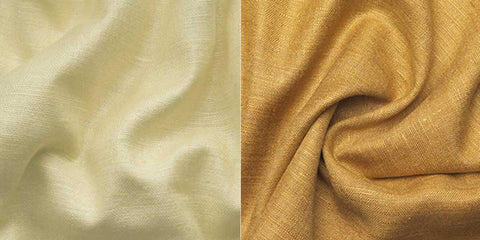
By Elena Tran
August 10, 2020
Silk is the most luxurious fabric that we can think of and despite various cheaper alternatives coming up on the market, nothing beats the real thing. The haute couturiers often use silk suiting fabrics in their collections and fashion writers like to refer to these fabrics, like raw silk fabric, due to the fact that they often have a plain crisscross weave that looks too simple and the term ‘raw’ suddenly makes sense. But there is nothing raw about these fabrics because they went through a number of processing steps in order to achieve the sophisticated Givenchy-worthy look.
The silk noil and raw silk are often used interchangeably to refer to silk fabric with linen-like plain weave and slightly nubby texture. I wanted to find out more in order to understand the difference. Internet sources explain these two terms in different ways, hence the confusion. The meaning of something raw is being in or nearly in the natural state: not processed or purified, in other words, raw fibers (Merriam Webster).
Therefore, raw silk refers to silk yarns before any finishing processing is done, such as de-gumming, dyeing, breaking, steaming, pressing and lustring. (Clive Hallett) Think about raw silk as one of the ingredients that go into a soft, smooth and brilliant silk that you buy at the store. It’s like cocoa that goes into a chocolate bar.
Silk noil, on the other hand, is woven from the fibers (noils) that were left over after spinning silk which already went through some chemical and physical processes prior to spinning, such as de-gumming. So instead of discarding these remnants, they are collected and woven into a fabric with an interesting texture. This is an example of waste upcycling in the textile industry.
Because noil fibers are shorter and weaker than regular silk fibers, this fabric doesn’t have that characteristic lustre although it still has a very subtle sheen. The term ‘raw silk’ is often used when referring to silk noil because it looks unprocessed with its irregular texture. But noil silk is dyed, steamed, and pressed to give a resulting fabric that is appealing to fashion designers and consumers.
Matka silk is an example of silk noil. It has a nubby texture that feels slightly dry and it has an elegant plain weave that looks like linen. The weight of the fabric varies from shirt weight to suiting which is also reflected in the prices. When you think of iconic Givenchy silk suits, this gorgeous fabric comes to mind.

Tussah and tasar silks are often used interchangeably. They only really differ in geography because the fibers used to spin these silk yarns are produced by the same type of wild silkworms. Tussah silk from China is produced by Antheraea pernyi silkworms which feed on oak leaves and it is a very common wild silk variety. The types of Chinese tussah silk used in couture are pongee, honan, dupioni and shantung. Because tussah can be easily dyed, you will find it in many different colours.
The Indian tasar silk is produced from wild Antheraea paphia silkworms which feed of various plants. (International Sericultural Commission) It has the same beautiful linen-like weave as tussah and similar slightly dominant weft. Natural colours of tasar silk range from cream to different shades of brown depending of the type of food the silkworms are feeding on. However, contemporary dying methods allow manufacturers to produce Tasar silk in many different colours.

A simple answer is no. Eri silk or endi silk is associated with ‘peace silk’ because the manufacturers claim that the silkworms are not destroyed in the process of making silk. (Clive Hallett). Eri silk is produced from Samia ricini silkworms which feed on castor plants (the word ‘eri’ literally means castor plant). (Mississipi State University) I am skeptical about ‘peace silk’ claims, but I am sure that there are producers trying to carve their niche in this specialty.
Indian muga silk from the wild Antheraea assamensis silkworms is considered to be one of the most expensive silk fabrics, the gold of silks. It is only produced in Assam state in India. ‘Muga’ means amber (brown) colour, the colour of the cocoons (WildSilkbase). The natural colour of muga silk is dark gold, but it often bleached and dyed to supply brightly coloured fabrics for Indian sarees.

Clive Hallett, Amanda Johnston. Fabric for Fashion: The Complete Guide. London: Laurence King Publishing Ltd., 2014.
International Sericultural Commission. http://www.inserco.org/en/types_of_silk. n.d.
Merriam Webster. https://www.merriam-webster.com/dictionary/raw. n.d.
Mississipi State University. https://mississippientomologicalmuseum.org.msstate.edu/AnthroEnt/Textiles/Species/Antheraea_pernyi.html#.Xyx5N4hKjIU. n.d.
Silk Mark India. http://www.silkmarkindia.com/blog/?p=167. n.d.
WildSilkbase. http://www.cdfd.org.in/wildsilkbase/info_moths.php. n.d.
